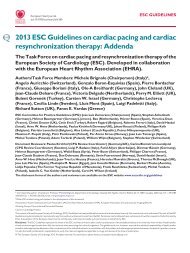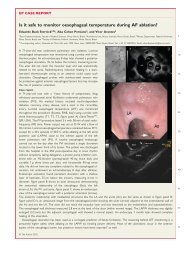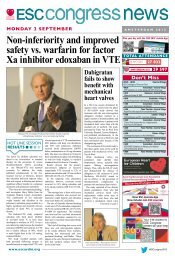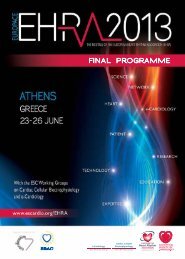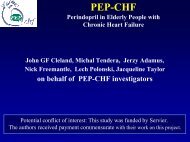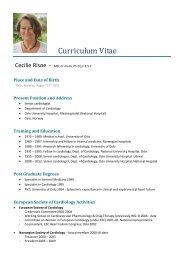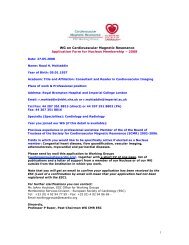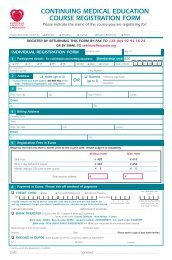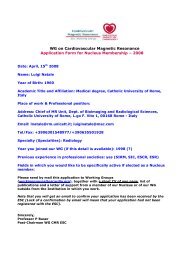EHS on Stable angina - Main publication - European Society of ...
EHS on Stable angina - Main publication - European Society of ...
EHS on Stable angina - Main publication - European Society of ...
Create successful ePaper yourself
Turn your PDF publications into a flip-book with our unique Google optimized e-Paper software.
The initial management <strong>of</strong> stable <strong>angina</strong> Page 9 <strong>of</strong> 12<br />
is apparent that in some countries, patients who were<br />
due to have invasive or specialized testing such as cor<strong>on</strong>ary<br />
angiography, myocardial perfusi<strong>on</strong> scanning, or<br />
stress echocardiography, were referred <strong>on</strong>wards for<br />
further care without follow-up arranged with the local<br />
cardiologist. For example, in the UK, more than half <strong>of</strong><br />
patients for whom no follow-up appointment had been<br />
made were <strong>on</strong> a waiting list for a cor<strong>on</strong>ary angiogram in<br />
another instituti<strong>on</strong>.<br />
The c<strong>on</strong>servatively managed group, who have had all<br />
requested investigati<strong>on</strong>s completed, and have been<br />
assigned to medical therapy, receive less intensive<br />
pharmacological treatment than the revascularizati<strong>on</strong><br />
group, with fewer patients receiving either anti-platelet<br />
or lipid-lowering therapy, although the use <strong>of</strong> anti<strong>angina</strong>l<br />
drug therapy is comparable. Thus, if an excess<br />
in cardiovascular morbidity and mortality is observed in<br />
the c<strong>on</strong>servatively treated group in the future, it<br />
cannot truly be described as ‘failure <strong>of</strong> treatment’ but<br />
rather ‘failure to treat’ as these patients have not been<br />
optimally medically managed. 17 A possible explanati<strong>on</strong><br />
may be that patients in whom the interventi<strong>on</strong>al<br />
approach is adopted are more likely to be treated in<br />
university or teaching instituti<strong>on</strong>s, not just with greater<br />
facilities, but also with a greater emphasis <strong>on</strong> evidencebased<br />
treatment. It has also been shown in the setting<br />
<strong>of</strong> acute cor<strong>on</strong>ary syndromes that the availability <strong>of</strong> invasive<br />
facilities <strong>on</strong> site increases the likelihood <strong>of</strong> use <strong>of</strong><br />
evidence-based sec<strong>on</strong>dary preventative therapy. 22 A key<br />
factor in the success <strong>of</strong> future <strong>European</strong> <strong>Society</strong> <strong>of</strong><br />
Cardiology guidelines will be their penetrati<strong>on</strong> to all<br />
strata <strong>of</strong> health care systems so that such dichotomy in<br />
treatment standards is attenuated.<br />
Revascularizati<strong>on</strong><br />
Although the overall revascularizati<strong>on</strong> rates seem low,<br />
when restricted to those in whom obstructive cor<strong>on</strong>ary<br />
disease has been documented within 4 weeks <strong>of</strong> the<br />
initial assessment, just over half have been referred<br />
for, or have had, a revascularizati<strong>on</strong> procedure, mostly<br />
PCI. This is substantially greater than the 19% <strong>of</strong> patients<br />
who underwent revascularizati<strong>on</strong> during a much l<strong>on</strong>ger<br />
period <strong>of</strong> follow-up in Ghandi’s study 23 <strong>of</strong> new cases<br />
<strong>of</strong> <strong>angina</strong> which included unstable <strong>angina</strong>, or other<br />
estimates <strong>of</strong> revascularizati<strong>on</strong> in stable <strong>angina</strong> 24–26<br />
and more in line with current studies <strong>of</strong> ACS. 15,27–29<br />
The overall number <strong>of</strong> revascularizati<strong>on</strong> procedures in<br />
the survey will inevitably rise as time progresses<br />
and more patients come to have scheduled angiography<br />
performed and analysed; however, as the highest-risk<br />
patients <strong>on</strong> clinical and n<strong>on</strong>-invasive testing were prioritized<br />
for earlier angiography, it is likely that the rate <strong>of</strong><br />
referral for revascularizati<strong>on</strong> may decelerate after the<br />
first m<strong>on</strong>th.<br />
Clinically appropriate reas<strong>on</strong>s for referral such as<br />
severe (CCS class III) symptoms or a positive exercise<br />
test are independently associated with a 2.5-fold<br />
increase in the likelihood <strong>of</strong> referral for revascularizati<strong>on</strong>,<br />
but women are <strong>on</strong>ly half as likely to be referred<br />
for revascularizati<strong>on</strong>, even when other potential<br />
c<strong>on</strong>founding features such as the results <strong>of</strong> exercise<br />
ECG, are adjusted for. Reports regarding a bias against<br />
revascularizati<strong>on</strong> in women have previously <strong>of</strong>fered c<strong>on</strong>flicting<br />
results. 30,31 The results <strong>of</strong> angiography were not<br />
recorded in all patients at the 4-week follow-up and it<br />
is not possible to comment <strong>on</strong> the potential effect <strong>of</strong><br />
angiographic results <strong>on</strong> this finding in this study. Type <strong>of</strong><br />
centre and prevailing nati<strong>on</strong>al rate <strong>of</strong> angiography are<br />
also independent predictors <strong>of</strong> revascularizati<strong>on</strong>, reflecting<br />
the influence <strong>of</strong> service capacity and availability <strong>of</strong><br />
<strong>on</strong>-site revascularizati<strong>on</strong> facilities <strong>on</strong> referral patterns.<br />
In centres/countries where there is sufficient capacity<br />
to perform angiography promptly, there may be a lower<br />
threshold to proceed to revascularizati<strong>on</strong> for fiscal as<br />
well as clinical reas<strong>on</strong>s.<br />
Limitati<strong>on</strong>s<br />
Although this was a survey <strong>of</strong> stable <strong>angina</strong>, because<br />
assessment by a cardiologist was chosen as the sampling<br />
point, the data may not be generalizable to the overall<br />
populati<strong>on</strong> with stable <strong>angina</strong> in the community,<br />
because <strong>of</strong> selecti<strong>on</strong> bias. However, the populati<strong>on</strong> is<br />
reflective <strong>of</strong> the patient pr<strong>of</strong>ile presenting to cardiologists<br />
and suitable for investigati<strong>on</strong> <strong>of</strong> their management<br />
practices. Inclusi<strong>on</strong> in the study was based <strong>on</strong> the diagnosis<br />
<strong>of</strong> <strong>angina</strong> by the attending physician, and is thus also<br />
open to interpretati<strong>on</strong> bias, but as patient management<br />
was based <strong>on</strong> the working diagnosis <strong>of</strong> <strong>angina</strong>, the populati<strong>on</strong><br />
is suitable for evaluati<strong>on</strong> <strong>of</strong> patient management.<br />
Because <strong>of</strong> the existing infrastructure in place at the<br />
time this survey was initiated, the survey is somewhat<br />
biased towards larger teaching or university-affiliated<br />
centres, with more centres with <strong>on</strong>-site catheterizati<strong>on</strong><br />
facilities than would be the case in practice. The enrolment<br />
<strong>of</strong> c<strong>on</strong>secutive patients, the increased recruitment<br />
<strong>of</strong> community hospitals, and the large populati<strong>on</strong><br />
recruited over a relatively short period <strong>of</strong> time have<br />
c<strong>on</strong>tributed to making this survey as representative <strong>of</strong><br />
clinical practice in Europe as possible within the c<strong>on</strong>straints<br />
<strong>of</strong> feasibility, and it c<strong>on</strong>tributes a truly unique<br />
data source to the literature. The numbers <strong>of</strong> patients<br />
from some <strong>of</strong> the 36 countries which c<strong>on</strong>tributed data<br />
are too small to be representative <strong>of</strong> practice in that individual<br />
country, but where trends in prevalence or practices<br />
emerge between countries in a regi<strong>on</strong>, the larger regi<strong>on</strong>al<br />
sample size is likely to be representative. Finally, given the<br />
potential sources <strong>of</strong> bias in the analysis, the results must<br />
be c<strong>on</strong>sidered as indicative rather than factual. In light<br />
<strong>of</strong> this, and as the nature <strong>of</strong> the study is exploratory<br />
rather than definitive, cauti<strong>on</strong> is advised in interpretati<strong>on</strong><br />
<strong>of</strong> the results, but the findings are n<strong>on</strong>etheless worthy <strong>of</strong><br />
c<strong>on</strong>siderati<strong>on</strong> and generate important questi<strong>on</strong>s as well<br />
as providing novel informati<strong>on</strong> in this area.<br />
C<strong>on</strong>clusi<strong>on</strong>s<br />
The survey has yielded mixed results. It is apparent that<br />
guidelines regarding treatment <strong>of</strong> modifiable cardiovascular<br />
risk factors and sec<strong>on</strong>dary preventive measures





